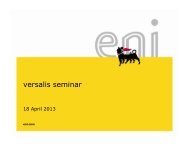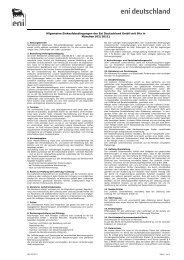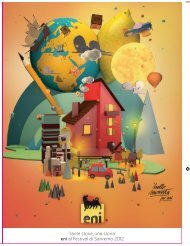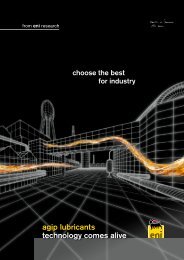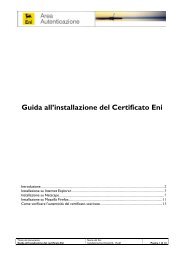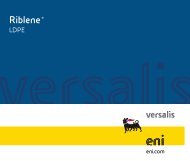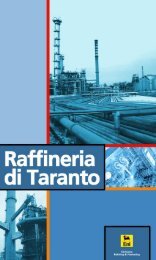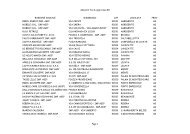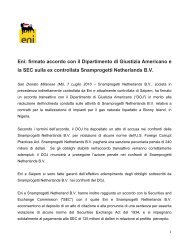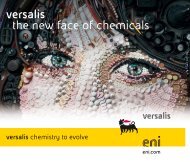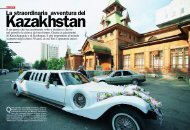È in corso il restauro conservativo del Duomo di Milano. Un ... - Eni
È in corso il restauro conservativo del Duomo di Milano. Un ... - Eni
È in corso il restauro conservativo del Duomo di Milano. Un ... - Eni
Create successful ePaper yourself
Turn your PDF publications into a flip-book with our unique Google optimized e-Paper software.
FOCUS<br />
stauro durata quattro lunghi anni, dall’altra, proprio grazie<br />
alla tecnologia messa a <strong>di</strong>sposizione da <strong>Eni</strong>Tecnologie sarà<br />
com<strong>in</strong>ciato davvero un nuovo modo, certamente più attento<br />
ed efficace, per compiere ulteriori <strong>in</strong>terventi conservativi.<br />
La Veneranda Fabbrica <strong>del</strong> <strong>Duomo</strong>, l’orga-<br />
nismo che dal 1387 ha <strong>il</strong> compito <strong>di</strong> provvedere<br />
alla conservazione <strong>del</strong>la cattedrale<br />
m<strong>il</strong>anese, avrà per la prima volta a <strong>di</strong>sposizione<br />
non soltanto un “database” aggiornato<br />
su ogni <strong>in</strong>tervento compiuto ma anche<br />
la possib<strong>il</strong>ità <strong>di</strong> avere al computer una<br />
visione tri<strong>di</strong>mensionale <strong>del</strong>la facciata. <strong>Un</strong>a<br />
visione realizzata da <strong>Eni</strong>Tecnologie con la<br />
fotogrammetria <strong>di</strong>gitale e <strong>il</strong> laser scann<strong>in</strong>g<br />
che permettono <strong>di</strong> mostrare ogni particolare<br />
con la precisione <strong>del</strong> m<strong>il</strong>limetro. Ed è<br />
<strong>in</strong>tuitivo come questa Banca Dati Integrata<br />
Tri<strong>di</strong>mensionale, unica nel suo genere,<br />
sarà estremamente ut<strong>il</strong>e per analizzare e<br />
pianificare nel tempo ulteriori <strong>in</strong>terventi.<br />
Insomma, se f<strong>in</strong>o ad oggi le perio<strong>di</strong>che<br />
campagne <strong>di</strong> conservazione e <strong>restauro</strong> volevano<br />
un po’ <strong>di</strong>re com<strong>in</strong>ciare ogni volta<br />
una nuova avventura d’ora <strong>in</strong> poi sarà <strong>in</strong>vece<br />
come proseguire lungo <strong>il</strong> f<strong>il</strong>o <strong>di</strong> una<br />
storia già com<strong>in</strong>ciata a narrare.<br />
Questa storia <strong>del</strong>la facciata <strong>del</strong> <strong>Duomo</strong> <strong>di</strong><br />
M<strong>il</strong>ano l’ha ora raccontata, <strong>in</strong>nanzitutto, <strong>il</strong><br />
georadar che, basandosi sui fenomeni <strong>di</strong><br />
propagazione e <strong>di</strong> riflessione <strong>di</strong> onde elettromagnetiche,<br />
ha permesso <strong>di</strong> descrivere<br />
lo stato <strong>di</strong> conservazione <strong>di</strong> strutture <strong>in</strong>terne,<br />
<strong>in</strong><strong>di</strong>cando la presenza <strong>di</strong> lesioni,<br />
fratture, <strong>di</strong>stacchi, cavità nascoste, umi<strong>di</strong>tà.<br />
La termografia, tecnica <strong>in</strong> grado <strong>di</strong> r<strong>il</strong>evare<br />
la temperatura superficiale dei materiali,<br />
è stata impiegata per verificare lo<br />
stato <strong>del</strong>le stuccature, identificando quelle<br />
<strong>di</strong>staccate, anche parzialmente, dal substrato<br />
marmoreo e qu<strong>in</strong><strong>di</strong> bisognose <strong>di</strong> <strong>restauro</strong>.<br />
Con la Spettrometria XRF, visto<br />
che i <strong>di</strong>versi elementi chimici rispondono<br />
<strong>in</strong> maniera <strong>di</strong>versa se eccitati da raggi X, è<br />
stata qu<strong>in</strong><strong>di</strong> <strong>in</strong>dagata la composizione <strong>del</strong><br />
materiale e dei prodotti <strong>di</strong> degrado, con<br />
l’aus<strong>il</strong>io anche <strong>di</strong> analisi <strong>di</strong> laboratorio con<br />
<strong>il</strong> microscopio elettronico a scansione, la<br />
<strong>di</strong>ffrattometria <strong>di</strong> raggi X e la termogravimetria.<br />
Ecco, è stato sulla base dei risultati <strong>di</strong><br />
questi r<strong>il</strong>ievi compiuti dall’équipe <strong>di</strong> <strong>Eni</strong>-<br />
Tecnologie – oltre 61 GByte <strong>di</strong> dati e <strong>in</strong>formazioni<br />
elaborate – guidata da Giuseppe<br />
Giunta e sulla “mappatura e la def<strong>in</strong>izione<br />
dei fenomeni e <strong>del</strong>le cause <strong>del</strong> degrado”<br />
effettuata con otto tavole tematiche dal<br />
Cnr che Benigno Mörl<strong>in</strong> Visconti Castiglione,<br />
<strong>di</strong>rettore <strong>del</strong>la Veneranda Fabbrica<br />
<strong>del</strong> <strong>Duomo</strong>, ha poi potuto pianificare i numerosi<br />
<strong>in</strong>terventi da compiere.<br />
Interventi enormi. Basta qualche numero.<br />
SPLENDORE MARMOREO.<br />
Il marmo <strong>di</strong> Candoglia viene<br />
ut<strong>il</strong>izzato esclusivamente<br />
per la costruzione e la manutenzione<br />
<strong>del</strong> <strong>Duomo</strong>.<br />
Si tratta <strong>di</strong> un calcare cristall<strong>in</strong>o<br />
<strong>di</strong> <strong>di</strong>versi colori: rosa, <strong>il</strong> più pregiato,<br />
bianco usato per lavori <strong>di</strong> ornato,<br />
e grigio per le strutture portanti.<br />
Nei secoli scorsi <strong>il</strong> marmo estratto<br />
dalle cave veniva lavorato <strong>in</strong> blocchi<br />
e poi trasportato su gran<strong>di</strong> barconi<br />
lungo i navigli <strong>di</strong> M<strong>il</strong>ano.<br />
MARBLE GLORY.<br />
The Candoglia marble may be used<br />
only to bu<strong>il</strong>d and repair the <strong>Duomo</strong>.<br />
It is a crystal limestone of various<br />
colours: p<strong>in</strong>k, the most valued one;<br />
white, used for ornaments,<br />
and grey, for bear<strong>in</strong>g structures.<br />
In the past centuries quarried marble<br />
was squared off <strong>in</strong>to blocks<br />
and carried by big barges down<br />
M<strong>il</strong>an’s canals.<br />
<strong>È</strong> stato eretto un ponteggio che ha raggiunto, all’<strong>in</strong>izio dei lavori,<br />
l’altezza <strong>di</strong> 65 metri. E dal 2003 ad oggi è stata effettuata,<br />
sotto la costante supervisione <strong>del</strong>la Sopr<strong>in</strong>tendenza per i<br />
beni ambientali e architettonici, la pulitura (con acqua nebulizzata<br />
e microsabbiatura JO) <strong>di</strong> tutta la<br />
facciata per una superficie sv<strong>il</strong>uppata <strong>di</strong><br />
14.000 metri quadrati; già term<strong>in</strong>ato è anche<br />
<strong>il</strong> <strong>restauro</strong> <strong>di</strong> do<strong>di</strong>ci guglie e sei falconature<br />
come <strong>di</strong> circa <strong>il</strong> trenta per cento <strong>del</strong>l’<strong>in</strong>tera<br />
facciata. F<strong>in</strong>ora sono state sostituite 192 statue<br />
<strong>di</strong> guglia, 40 statue gran<strong>di</strong>, 40 mensole, 88<br />
teste, 22 telamoni <strong>di</strong> cui sei doppi, 47 altor<strong>il</strong>ievi,<br />
36 mensole con testa, 42 gabbioni e ci sono<br />
poi le lastre <strong>di</strong> copertura... 1.362 sono i pezzi<br />
sostituiti con altrettanti nuovi <strong>in</strong> marmo <strong>di</strong><br />
Candoglia e naturalmente gli orig<strong>in</strong>ali <strong>di</strong> statue,<br />
teste, altor<strong>il</strong>ievi sono dest<strong>in</strong>ati al Museo<br />
<strong>del</strong> <strong>Duomo</strong>.<br />
“Il marmo <strong>di</strong> Candoglia è una pietra meravigliosa”<br />
osserva Benigno Mörl<strong>in</strong> Visconti Castiglione<br />
da <strong>di</strong>etro i suoi <strong>in</strong>consueti lunghi baffi<br />
st<strong>il</strong>e Ottocento, “ma con <strong>il</strong> problema <strong>di</strong> essere<br />
un carbonato <strong>di</strong> calcio e qu<strong>in</strong><strong>di</strong> fac<strong>il</strong>mente aggre<strong>di</strong>b<strong>il</strong>e<br />
dall’<strong>in</strong>qu<strong>in</strong>amento oltre che dall’e-<br />
BACK TO A NEW LIFE<br />
After St. Peter’s Bas<strong>il</strong>ica, it’s the <strong>Duomo</strong><br />
of M<strong>il</strong>an’s turn to sh<strong>in</strong>e aga<strong>in</strong> thanks<br />
to the know-how of <strong>Eni</strong>Technologie,<br />
via a constructive relationship between<br />
o<strong>il</strong> techniques and restoration methods.<br />
by LUCIANO SIMONELLI<br />
THE FACADE OF THE DUOMO OF MILAN IS SLOWLY<br />
beg<strong>in</strong>n<strong>in</strong>g to reveal itself anew. The top 20 metres have<br />
just become visible aga<strong>in</strong> – with the consolidated and<br />
restored 12 steeples and 6 tracery panels with their<br />
ornamental small pyramids, bows. balusters and baldach<strong>in</strong>s –<br />
provid<strong>in</strong>g a first sample of the complex labour that is be<strong>in</strong>g<br />
undertaken to br<strong>in</strong>g the Cathedral back to its orig<strong>in</strong>al<br />
splendour, an excellent job <strong>in</strong> the sight of which Francesco<br />
Zofrea’s normally restra<strong>in</strong>ed face breaks <strong>in</strong>to a sm<strong>il</strong>e.<br />
<strong>Eni</strong>Tecnologie’s chairman is clearly satisfied with the way the<br />
“M<strong>il</strong>an <strong>Duomo</strong> Project” is com<strong>in</strong>g along: “it puts a seal on the<br />
process of transferr<strong>in</strong>g company technologies, as applied to o<strong>il</strong><br />
well rocks, to the marble of monuments, clearly a more<br />
valuable material. We first embarked on it a few years back,<br />
with the façade restoration at St Peter’s bas<strong>il</strong>ica. Cutt<strong>in</strong>g edge<br />
technologies – Zofrea goes on – we typically apply to<br />
geological prospect<strong>in</strong>g and survey<strong>in</strong>g as well as to monitor<strong>in</strong>g<br />
o<strong>il</strong> and gas extraction fac<strong>il</strong>ities and are here applied to the<br />
<strong>Duomo</strong>, allow for more effective restoration methods and<br />
provide results which would be hard to achieve otherwise”.<br />
There’s more: “<strong>Eni</strong>Tecnologie w<strong>il</strong>l pursue such commitments<br />
and w<strong>il</strong>l pass both its know-how and tools on to other<br />
restoration endeavours. To us, heritage conservation and<br />
ensur<strong>in</strong>g the country’s energy supplies are equally relevant<br />
objectives”.<br />
A pledge which as of now is set to make a <strong>di</strong>fference <strong>in</strong> the<br />
conservation of Italy’s immense art heritage, as proved by<br />
ongo<strong>in</strong>g restoration work on the M<strong>il</strong>an <strong>Duomo</strong> façade. Once<br />
M<strong>il</strong>an’s foremost symbol is restored to a full show of its<br />
“face”, <strong>in</strong> all its slightly p<strong>in</strong>k Condoglia-marble candour – a<br />
four-year <strong>in</strong>tensive restoration campaign w<strong>il</strong>l have been<br />
completed and thanks to <strong>Eni</strong>Tecnologie technologies that day<br />
w<strong>il</strong>l also usher <strong>in</strong> a new age <strong>in</strong> conservation work, engender<strong>in</strong>g<br />
greater focus and effectiveness.<br />
The Veneranda Fabbrica <strong>del</strong> <strong>Duomo</strong>, which was established <strong>in</strong><br />
1387 and charged with ensur<strong>in</strong>g the M<strong>il</strong>anese cathedral’s<br />
conservation, is now equipped with an updated database of all<br />
work done, plus a three-<strong>di</strong>mensional computer generated view<br />
of the facade. The latter was developed by <strong>Eni</strong>Tecnologie us<strong>in</strong>g<br />
<strong>di</strong>gital photogrammetry and laser scann<strong>in</strong>g techniques, and<br />
provides one m<strong>il</strong>limetre resolution on all deta<strong>il</strong>s of the façade.<br />
Needless to say the <strong>in</strong>tegrated 3D database w<strong>il</strong>l prove<br />
precious <strong>in</strong> def<strong>in</strong><strong>in</strong>g and plann<strong>in</strong>g further restoration work <strong>in</strong><br />
the future. To all <strong>in</strong>tents and purposes, prior scheduled<br />
conservation and restoration campaigns <strong>in</strong>volved start<strong>in</strong>g<br />
virtually afresh every time; from now on, <strong>in</strong>stead, future work<br />
w<strong>il</strong>l pick up from where it was left off, <strong>in</strong> cont<strong>in</strong>uity.<br />
This history of the façade of the <strong>Duomo</strong> has now been told,<br />
above all, by the Georadar which, based on the phenomena of<br />
the propagation and reflection of electromagnetic waves, has<br />
allowed for the description of the con<strong>di</strong>tion of <strong>in</strong>ternal<br />
structures, identify<strong>in</strong>g cracks, breaks, gaps, hidden cavities<br />
and moisture. Thermography, a technique capable of tak<strong>in</strong>g<br />
the surface temperature of materials, has been used to<br />
control the state of plaster<strong>in</strong>g, identify<strong>in</strong>g which ones have<br />
grown loose, even if just <strong>in</strong> part, from the underly<strong>in</strong>g marble<br />
and so <strong>in</strong> need of repairs.<br />
XRF Spectrometry, s<strong>in</strong>ce chemical elements respond<br />
<strong>di</strong>fferently when excited by X-rays, helped to <strong>in</strong>vestigate the<br />
composition of the material and the products of degradation,<br />
with ad<strong>di</strong>tional assistance provided by laboratory analysis<br />
us<strong>in</strong>g an electronic microscope.<br />
It was on the basis of the results of this research – over 61<br />
Gbytes of data and <strong>in</strong>formation processed – conducted by the<br />
<strong>Eni</strong>Tecnologie team headed by Giuseppe Giunta and of the<br />
“mapp<strong>in</strong>g and def<strong>in</strong>ition of the phenomena and causes of<br />
degradation” carried out with eight thematic tables by CNR<br />
(Italy’s National Research Counc<strong>il</strong>) that Benigno Mörl<strong>in</strong><br />
Visconti Castiglione, head of the Veneranda Fabbrica <strong>del</strong><br />
<strong>Duomo</strong>, was then able to plan the work to be done.<br />
Huge work. A few figures w<strong>il</strong>l suffice.<br />
Scaffold<strong>in</strong>g 65-metre-high was set up when the work began.<br />
And s<strong>in</strong>ce 2003, under the constant supervision of the<br />
Environmental and Architectural Heritage Office, the entire<br />
22 <strong>Eni</strong>’s Way<br />
<strong>Eni</strong>’s Way<br />
23



